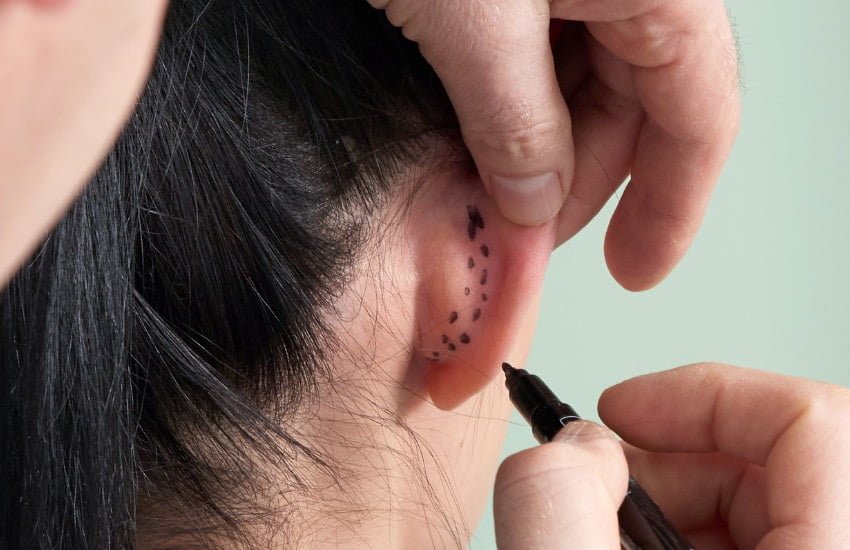Are you concerned about the size or shape of your ears? Overly large, misshapen, or protruding ears are a relatively common issue, but can easily leave you feeling self-conscious as they draw people’s attention away from your otherwise attractive facial features.
Fortunately, these issues can easily be rectified with otoplasty surgery!
Otoplasty is a cosmetic surgery that can be used to correct the shape, size, and position of the ears. It can also be used to correct protruding ears, a procedure known as ear pinning.
Surgery performed by an experienced plastic surgeon like Dr. Kachniarz, can help those who are self-conscious about their outer ears feel more confident with their overall appearance.
What Is Otoplasty?
Otoplasty surgery, also known as ear reshaping, or ear pinning, is a cosmetic procedure which changes the shape, size, or position of a patient’s outer ears to achieve the desired shape. It can be used to correct abnormalities such as ears which are protruding, misshapen, or oversized. In some cases, it may even be medically necessary.
Otoplasty usually involves making small incisions in the natural creases behind the ears and removing excess skin and cartilage to improve their shape or size. The skin is then pulled back over the newly shaped cartilage and sutured closed.
The process typically takes one to two hours depending on how much work needs to be done on each ear and is usually performed under local anesthesia.

Benefits of cosmetic Ear Surgery
Plastic surgery is an excellent way to rectify the appearance of your external ear and overall facial harmony without having to go through a severe operation. It is a minimally invasive operation that carries little risk and can be done in a few hours at most. Some of the main benefits include:
- Improves the appearance of your external ear: Plastic surgery can enhance the overall appearance of your ears and bring them into better proportion with the rest of your face. It can address concerns such as overly prominent ears, asymmetry, irregularities, or deformities.
- Enhances facial harmony: Ear pinning procedures can bring the ears closer to your head or reshape them to create better overall facial harmony, resulting in a more balanced appearance.
- Boosts self-esteem: Many patients who feel self-conscious about the appearance of their ears experience a significant boost in self-confidence after having a surgery. Correcting imperfections in your appearance can help improve your self-esteem and increase social comfort.
- Can correct birth defects or injuries: Surgery can address congenital ear deformities or injuries that have affected the shape or structure of your ears. It is performed on both children and adults to correct such conditions.
Are You an Ideal Candidate?
Cosmetic ear surgery is an increasingly popular procedure that can be performed on both adults and children (over the age of five) who are concerned about the size, shape, or position of their ears.
Specifically, the ideal candidates for ear reshaping surgery include:
- Children or adults who have protruding or prominent ears that cause embarrassment and self-consciousness.
- Patients with ear abnormalities due to congenital deformities or injuries sustained in accidents or sports.
- Those who are looking to repair torn or stretched earlobes.
If you feel you might be the right candidate for surgery, schedule a free consultation with Dr. Kachniarz. He can evaluate your issues and help you determine whether ear surgery would be the best way to solve them.
He will also develop a plan that fits your individual situation, advising you on what kind of surgical technique would work best and providing you with information about potential risks and benefits associated with the procedure so you can have realistic expectations.
What Are the Different Procedures Used?
There are several types of otoplasty techniques, including:
1. Ear Pinning
Ear pinning is one of the most commonly performed types of ear surgery. It is used to correct protruding ears that stick out from the head. The aim of ear pinning is to bring the ears closer to the sides of the head while reshaping deformed cartilage.
2. Earlobe Repair or Reduction
Earlobe repair or earlobe reduction is performed to address issues related to the earlobes. This includes repairing torn or cleft earlobes, removing keloid scars, and reducing the size or protrusion of the earlobe.
For torn or cleft earlobes, the procedure involves reconstructing the damaged tissue by carefully suturing the edges back together. This effectively restores a natural and aesthetically pleasing appearance.
Earlobe reductions make use of incisions through which local tissue is re-arranged according to the patient’s anatomy and objectives.
Earlobe surgery is a minor operation which is often performed in the office under local anesthesia, unless it is being done in conjunction with other types of facial surgery in the operating theater.
3. Ear Reconstruction
Ear reconstruction or auricular reconstruction is a type of surgical intervention designed to restore form and function of the external ear after trauma or to fix congenital defects.
It is used to correct issues such as microtia (underdeveloped ear), cryptotia (where part of the ear is buried under the skin), or an ear that has extra folds of skin or is folded over itself.
4. Ear Reduction
Ear reduction involves surgically removing tissue from the ears to make them smaller. It is used on patients suffering from large ears (macrotia).

Alternatives to Otoplasty
Ear Pinning Without Incisions
Incisionless ear pinning, also known as non-surgical otoplasty, is a procedure for correcting protruding or misshapen ears without the need for traditional surgical incisions.
Unlike traditional ear pinning surgery, which involves making incisions behind the ears to reshape the cartilage, incisionless ear pinning utilizes specialized sutures to reshape the ears without any external cuts or scars.
Incisionless ear pinning cannot be used in all cases, so you will have to consult with Dr. Kachniarz to determine whether you are a suitable candidate.
Ear Molding
Another alternative to otoplasty is ear molding, typically used on infants with ear deformities. Ear molding involves the use of specially designed molds, surgical tape, or splints to reshape and reposition the infant’s ears during the first weeks or months of life when the ear cartilage is still soft and malleable.
For best results, ear molding should be performed in the first 4 weeks of a newborn’s life but can still be attempted up to 2–3 months of age.
Surgery Procedure: Before, During, and After
Before: Pre-Surgery Preparation
The first step on the road to having an otoplasty is to consult with a plastic surgeon like Dr. Kachniarz. During this otoplasty consultation, you can explain your issues and discuss your desired outcome from the operation. Questions and concerns will be addressed, and Dr. K will create a personalized treatment plan tailored to your needs.
Specifically, during the first consultation, Dr. Kachniarz will most likely do the following:
- Review your medical background: Dr. Kachniarz will ask questions about your present and past medical conditions, particularly any occurrences of ear infections. You will also be asked to provide details on any medications you are currently taking or have recently taken, as well as any previous surgeries you have undergone.
- Conduct a physical examination: Dr. Kachniarz will assess your ears, taking note of their position, size, shape, and symmetry to determine the suitable treatment options. Photographs of your ears might be taken for your medical records.
- Discuss your objectives and expectations: You will discuss the reasons behind your interest in otoplasty and the specific outcomes you anticipate from the procedure. Dr. Kachniarz will also go over the potential risks involved to make sure you are confident and comfortable proceeding with the surgery.
After going over your medical history, undergoing a physical examination, and discussing your goals with Dr. Kachniarz, he will determine whether you are the right candidate for otoplasty and develop a personalized treatment plan.
He will then advise you on how to best prepare for the procedure to ensure you’re in good health before the operation.
This usually includes:
- Avoiding certain foods and medications which can interfere with the operation and increase bleeding, such as aspirin and anti-inflammatories.
- Eating a healthy diet and getting plenty of rest.
- Stopping smoking before and after surgery if you are a smoker.
- Limiting alcohol consumption before and after the operation.
- Making plans for a friend or family member to drive you home after operation and help provide care during the first day or two of recovery while you have your head elevated during the operation.
During: The Procedure
During the actual surgical procedure, incisions will be made in accordance with the specific otoplasty technique being used. Incisions may either be made behind the ears and along their outer edge where needed, or within the inner creases of the ears.
Cartilage is then reshaped or trimmed as necessary and excess skin removed before sutures are applied to hold it in place.
Most otoplasty surgeries are performed under local anesthesia unless it requires a more extensive operation, is performed in conjunction with other more invasive facial surgeries, or the patient specifically requests general anesthesia.
The otoplasty procedure typically takes one to two hours.
After: Post-Surgery Recovery
After the procedure, soft dressings are placed over the ears to protect them and aid in the healing process. These dressings are usually removed within the first week.
During the recovery period, you will feel mild to moderate pain and discomfort in the ears. Dr. Kachniarz will prescribe pain medication to help manage the discomfort.
You should avoid sleeping on your side to keep the pressure off your ears. You should also avoid rubbing or disturbing the incision site, so it can be helpful to wear button-up shirts or clothes with loose collars to avoid accidentally knocking the wounds.
The recovery period following an otoplasty is just as important as the actual surgery itself. Once Dr. Kachniarz has completed the operation, it’s essential to be mindful of how you take care of yourself to get optimal results.
The average recovery period is approximately one to two weeks, after which you can return to work and resume most of your normal daily activities.

What Are the Risks?
While an otoplasty is minimally invasive and low-risk procedure, like any operation, it does carry some potential risks and complications that you should be aware of. These risks include:
- Hematoma,
- Bleeding,
- Adverse reaction to anesthesia,
- Post-operative infection,
- Asymmetry in-ear placement,
- Under or over-correction,
- Visible scarring.
What Is the Cost of Otoplasty in Miami?
The cost of an ear surgery in Miami is from $2,000 – $6,000 depending on several factors, such as the type and extent of the treatment and whether complementary procedures are included.
As each surgical plan is uniquely tailored to your personal requirements and objectives, the price can vary significantly. It’s important to consult with Dr. K in person to get an accurate estimate of the total cost. He can also help advise on potential financing options if you are unable to cover the costs upfront.
The success and safety of your procedure in Miami is dependent on choosing the right plastic surgeon. Dr. Kachniarz and his team at have extensive experience performing otoplasties with excellent results.
Schedule a consultation today to discuss what you should consider before undergoing an ear surgery and determine if it is the right choice for you.
When Will I Be Able To See My Results?
The good news is that you will be able to see visible immediate results after your bandages are removed, typically within one week of surgery. The final results will become clear once the swelling has fully subsided and your ears have had time to fully heal, which can take several weeks.
By the end of the second week, the majority of the visible swelling should have subsided, and after 4–6 weeks the swelling should be barely noticeable. It may take a few more months for the final results of otoplasty to fully manifest.
The improvements in your ear size and appearance are permanent once the healing process is complete and you are fully healed.
Can Other surgeries Be Done at the Same Time?
Yes, in many cases, other procedures such as a facelift or eyelid surgery can be performed at the same time as otoplasty.
It is important to discuss the possibility of combining other facial plastic surgery procedures with your surgeon during the initial consultation. Combining surgeries can be advantageous as it may reduce overall operation time, anesthesia fees, and recovery period.
Frequently Asked Questions
Can My Child Have Ear Surgery?
Yes, pediatric otoplasty is typically recommended for children between the ages of five and fourteen. Before this age, the ear cartilage may still be too soft and not fully developed, which could impact the success of the procedure.
However, eligibility for pediatric otoplasty depends on your child’s unique circumstances and physiology.
How Long Does Surgery Take?
On average, an otoplasty takes around 1 to 2 hours to complete. However, the exact duration may vary depending on the complexity of the individual case and the specific surgical technique used.
If the surgery is combined with other cosmetic procedures, it will naturally take longer.
Will I Have To Take Time off Work After Surgery?
The recovery time after otoplasty varies from person to person, but in general, you can expect to have to take some time off work to allow for proper healing, typically about two weeks.
The duration of your recovery and when you can safely return to work will depend on several factors, including the specific surgical technique used, the extent of the correction performed, your body’s healing response, and the type of work you do. The average recovery period is approximately one to two weeks.
Will Surgery Leave Scars?
Otoplasty does result in some scarring, but the incisions are typically made behind the ear or within the natural fold, resulting in scars that are well hidden. This helps ensure a more natural and aesthetically pleasing outcome.
That said, the size and appearance of visible scarring can be influenced by various factors, including the individual’s healing ability, the extent of the surgery, and the techniques used by the surgeon.
Is Otoplasty Painful?
Otoplasty is not considered to be very painful in comparison to other, more invasive plastic surgeries; however, it does still result in some pain, itching, and discomfort. Most patients find that regular oral medication is sufficient for managing any pain or skin sensation issues after the operation.
Will My Child Get Frequent Ear Infections After Ear Pinning Surgery?
Ear pinning surgery itself does not increase the risk of infections in the child’s ears. During the initial consultation, the surgeon will thoroughly evaluate your child’s medical history.
If a child is currently experiencing frequent ear infections, the surgeon may suggest delaying the operation until the infections are under control.
Once the surgery is performed and your child heals fully, there should be no increase in the risk of ear infections. This is because the surgery only involves reshaping and repositioning the cartilage and skin of the outer ear, but it does not have any impact on the ear’s internal structures.
References
[1] Nazarian R, Eshraghi AA. Otoplasty for the protruded ear. Semin Plast Surg. 2011;25(4):288-294. doi:10.1055/s-0031-1288921. National Library of Medicine. https://www.ncbi.nlm.nih.gov/pmc/articles/PMC3312149/
[2] Naumann A. Otoplasty – techniques, characteristics and risks. GMS Curr Top Otorhinolaryngol Head Neck Surg. 2007;6:Doc04. National Library of Medicine. https://www.ncbi.nlm.nih.gov/pmc/articles/PMC3199845/



